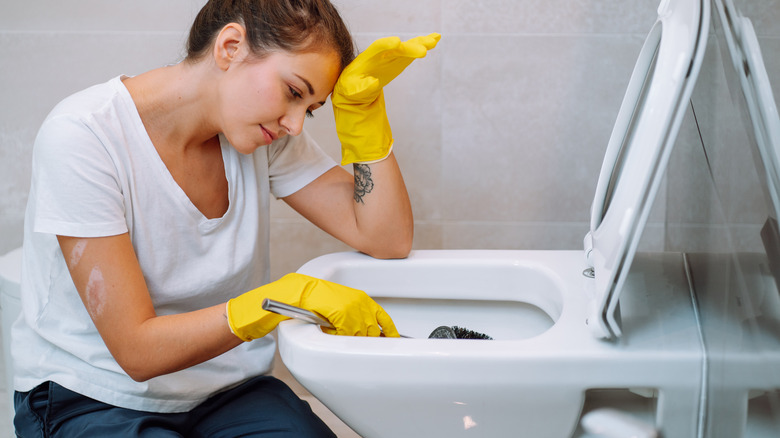Unclog Your Toilet Trap: A Pro's Guide

Battling the Blockage: A Homeowner's Guide to Unclogging a Toilet
A clogged toilet is a common household frustration. The sinking feeling when you flush and the water level begins to rise instead of swirling down the drain is familiar to most homeowners. Before reaching for the phone to call a plumber, it's worth investigating the cause of the clog and attempting some DIY solutions. Understanding the likely culprit and employing the right tools can often restore your toilet to working order.
Understanding the Toilet Trap
The first step in tackling a clogged toilet is understanding its anatomy, specifically the toilet trap. This is the curved section at the base of the toilet. Its primary function is to hold a small amount of water, creating a seal that prevents sewer gases from entering your home. However, its shape and location also make it a prime spot for clogs. Items like excessive toilet paper, feminine hygiene products, mineral buildup from hard water, or even small toys can easily become lodged in the trap. Regular cleaning often overlooks this area, allowing buildup to accumulate and contribute to blockages.
The Plunger: Your First Line of Defense
When faced with a clogged toilet, the plunger should be your first tool of choice. However, not all plungers are created equal. A flange plunger, designed with an extendable rubber flap at the bottom, is specifically engineered to create a tighter seal in the toilet bowl. This type of plunger is far more effective than a standard cup plunger.
Here's how to use a flange plunger effectively:
- Gear Up: Put on rubber gloves to protect your hands.
- Water Level: Ensure there's enough water in the bowl to cover the flange of the plunger. If necessary, add some water.
- Positioning: Place the plunger at an angle to allow the flange to fill with water. This helps create a better seal.
- Initial Plunge: Gently press the plunger down over the drain opening to create a tight seal. Begin with gentle pushes to expel any trapped air and prevent splashing.
- Plunging Action: Once a good seal is established, plunge with firm, steady, rhythmic motions. The goal is to create pressure that will dislodge the blockage in the trap.
If plunging doesn't produce results after several attempts, it's time to move on to the next strategy.
The Toilet Auger: Reaching Deeper
A toilet auger, also known as a closet auger, is a specialized tool designed to reach deeper into the toilet trap to break up or retrieve the clog. It features a flexible cable with a curved end that can navigate the bends of the toilet drain.
To use a toilet auger:
- Gentle Insertion: Carefully insert the tip of the auger into the toilet bowl opening.
- Crank the Handle: Begin cranking the handle of the auger to advance the cable into the drain.
- Feel for Resistance: When you encounter resistance, this indicates you've reached the clog.
- Break Up or Retrieve: Rotate the auger handle to break up the clog or attempt to hook and pull it out.
- Remove the Auger: Carefully retract the auger, and dispose of any debris that is retrieved.
Sometimes, a combination of plunging followed by the use of a toilet auger is the most effective way to clear a stubborn clog.
Alternative Methods for Clearing a Toilet Trap
If plunging and augering haven't solved the problem, there are a few other household remedies you can try before calling a professional plumber.
-
Dish Soap and Hot Water: Pour about a quarter of a cup of dish soap into the toilet bowl. After a few minutes, carefully add a bucket of very hot (but not boiling) water. Let the mixture sit for 10 to 15 minutes. The dish soap acts as a lubricant and helps break down grease and organic matter, making it easier for the clog to dislodge.
-
Baking Soda and Vinegar: This classic combination can be used to tackle toilet clogs. Pour one cup of baking soda into the toilet bowl, followed by two cups of vinegar. The mixture will fizz and bubble, creating a natural reaction that can help loosen the clog. Allow the mixture to work for at least 30 minutes before flushing.
When to Call a Plumber
While these DIY methods can be effective for many toilet clogs, there are times when calling a professional plumber is the best course of action. If you've tried all the above methods and the toilet remains clogged, or if you suspect the clog is located deeper in the drain line, it's time to seek professional help. Attempting to force the issue could potentially damage your plumbing system.
Preventing Future Clogs
Once you've successfully unclogged your toilet, it's wise to take steps to prevent future blockages. Some helpful tips include:
- Use Toilet Paper Sparingly: Avoid using excessive amounts of toilet paper.
- Proper Disposal: Never flush feminine hygiene products, diapers, wipes, or other non-flushable items down the toilet.
- Regular Cleaning: Periodically clean your toilet trap to prevent buildup.
- Enzyme-Based Drain Cleaner: Consider using an enzyme-based drain cleaner for regular maintenance. These cleaners use enzymes to break down organic matter and help keep your drains flowing freely.
By understanding the anatomy of your toilet, employing the right tools and techniques, and taking preventative measures, you can effectively tackle most toilet clogs and avoid costly plumbing bills.
